Table of Contents
- Introduction
- Editor’s Choice
- Online Food Delivery Statistics by Consumer
- Global Online Food Delivery Market Revenue Statistics
- Online Food Delivery Regional Statistics
- Online Food Delivery Statistics by Top Companies
- Online Food Delivery Statistics by Consumer Behaviour
- Online Food Delivery Customer Preference Statistics
- Recent Developments
- Conclusion
- FAQs
Introduction
Online Food Delivery Statistics: This Refers to the process of using digital platforms like websites or mobile apps to order and receive food items from restaurants or cafes.
Customers have the convenience of browsing menus, selecting dishes, customizing orders, and making online payments.
After placing an order, the chosen food provider prepares the food and delivers it to the customer’s specified location. Either through third-party delivery services or their delivery teams.
This method of obtaining a variety of cuisines has transformed the way people access ready meals. Providing them with more choices and greater convenience. Especially at a time when technology and mobile devices play a significant role in our lives.
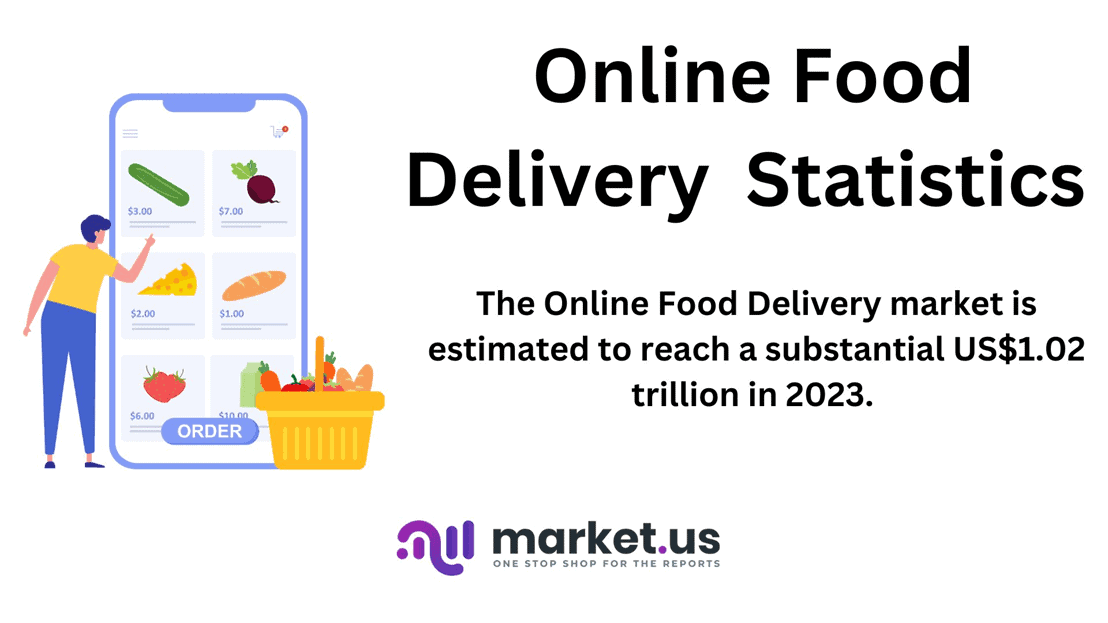
Editor’s Choice
- The projected revenue for the Online Food Delivery Market is estimated to reach a substantial US$1.02 trillion in 2023. With an expected annual growth rate (CAGR) of 12.78% from 2023 to 2027, resulting in a market volume of approximately US$1.65 trillion by 2027.
- The Asia Pacific region is anticipated to emerge as the most profitable industry. Within the global online food delivery market, it has a substantial market share of 37%.
- In the fiscal year 2022, Zomato recorded revenue exceeding 55 billion Indian rupees. The majority of its revenue came from its food delivery services. Although Zomato held a dominant position in the market, its closest rival in recent times has been Swiggy.
- In 2022, Uber Eats, the food delivery company, achieved global revenues of nearly 11 billion U.S. dollars. This amount signifies a notable increase of 31% compared to the previous year when the company generated 8.3 billion dollars in revenue.
- In 2022, Deliveroo saw a revenue of £1.9 billion, marking an 8.2% increase compared to the previous year.
Moreover
- In 2022, Grubhub reported a revenue of $2.4 billion, marking a 5% year-on-year increase. During the same period, the company’s gross transaction volume hit $10.1 billion.
- DoorDash, the U.S.-based food delivery company, witnessed a substantial revenue surge in recent years. In 2021, it generated $4.8 billion, nearly doubling its previous year’s results.
- Gen Z has a strong affinity for online ordering, finding it more convenient than traditional paper menus. According to a recent study by e-marketer, over 55% of consumers in the 18-25 age group embraced online ordering in the past year.
- As per the study, 37.3% of respondents within the 18 to 30-year-old age group reported using food delivery platforms to order food once a month. While an additional 33.3% use these platforms less than three times a week.
Online Food Delivery Statistics by Consumer
- Approximately 60% of customers in the United States place online food orders at least twice a week, indicating a significant frequency of online food ordering.
- Furthermore, 57% of millennials prefer having their meals delivered to their homes. Highlighting a strong demand for food delivery services among this demographic.
- The compound annual growth rate (CAGR) for revenue in the online food delivery sector is estimated to be 8.38% from 2022 to 2026. Resulting in a projected market volume of USD 474.30 billion by 2026.
- In the Platform-to-Consumer Delivery segment, the largest sector, the market is anticipated to be valued at $217.80 billion in 2022.
- Regarding the Average Revenue Per User (ARPU), it is expected to reach US$177.10 in 2022 within the Online Food Delivery sector.
- Looking ahead, it is estimated that the number of online food delivery consumers will reach 2,691.0 million by 2026. Indicating the continued growth and adoption of online food delivery services.
(Source: Intelivita)
Global Online Food Delivery Market Revenue Statistics
- The projected revenue for the Online Food Delivery market is estimated to reach a substantial US$1.02 trillion in 2023. With an expected annual growth rate (CAGR) of 12.78% from 2023 to 2027, resulting in a market volume of approximately US$1.65 trillion by 2027.
- Notably, the Grocery Delivery segment is anticipated to experience robust revenue growth of 22.2% in 2024.
- The Grocery Delivery segment represents the largest segment, with a projected market volume of around US$0.63 trillion in 2023.
- On a global scale, China is expected to generate the highest revenue, reaching approximately US$395.9 billion in 2023.
- Furthermore, the Average Revenue Per User (ARPU) in the Grocery Delivery segment is estimated to be about US$449 in 2023.
- In terms of Meal Delivery, user numbers are forecasted to reach an impressive 2.5 billion users by 2027. With a user penetration rate of 25.2% in the Meal Delivery segment in 2023.
(Source: Statista)
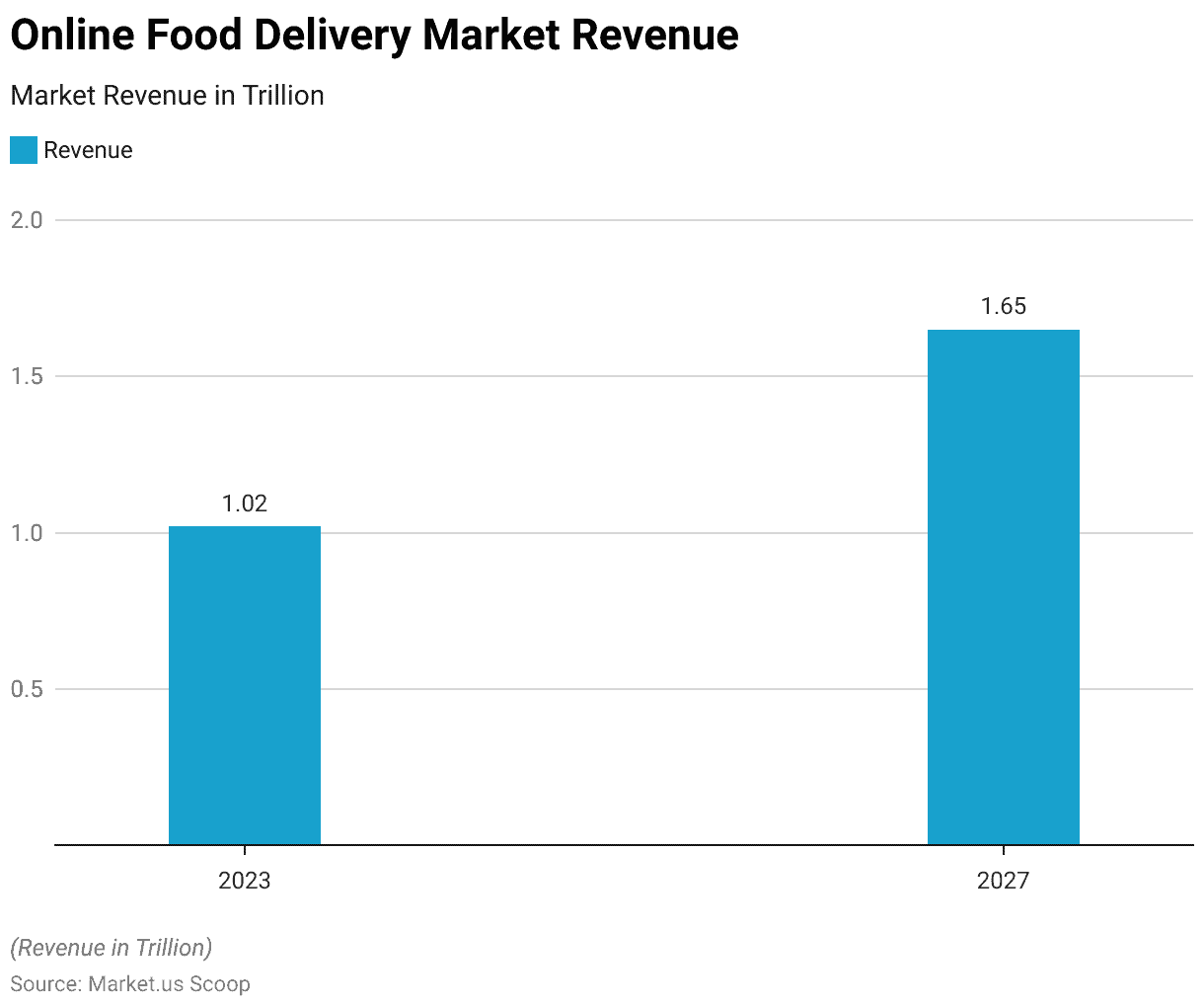
Online Food Delivery Regional Statistics
India Online Food Delivery Statistics
- Anticipated revenue in the Indian Online Food Delivery market in 2023 is expected to reach approximately US$33.36 billion.
- Furthermore, the market is projected to exhibit an annual growth rate (CAGR) of 21.78% from 2023 to 2027. Resulting in a forecasted market volume of about US$73.38 billion by 2027.
- It’s worth noting that the Grocery Delivery segment is poised to experience significant revenue growth of 38.2% in 2024.
- Currently, the largest segment within this market is Grocery Delivery. With an estimated market volume of roughly US$22.17 billion in 2023.
- In a global context, China is expected to contribute the most revenue, with an estimated US$395.9 billion in 2023.
- Moreover, the Average Revenue Per User (ARPU) in the Grocery Delivery segment is predicted to be around US$158.50 in 2023.
- Regarding the Meal Delivery segment, user numbers are anticipated to reach approximately 330.8 million users by 2027, with a user penetration rate of 16.2% in 2023.
(Source: Statista)
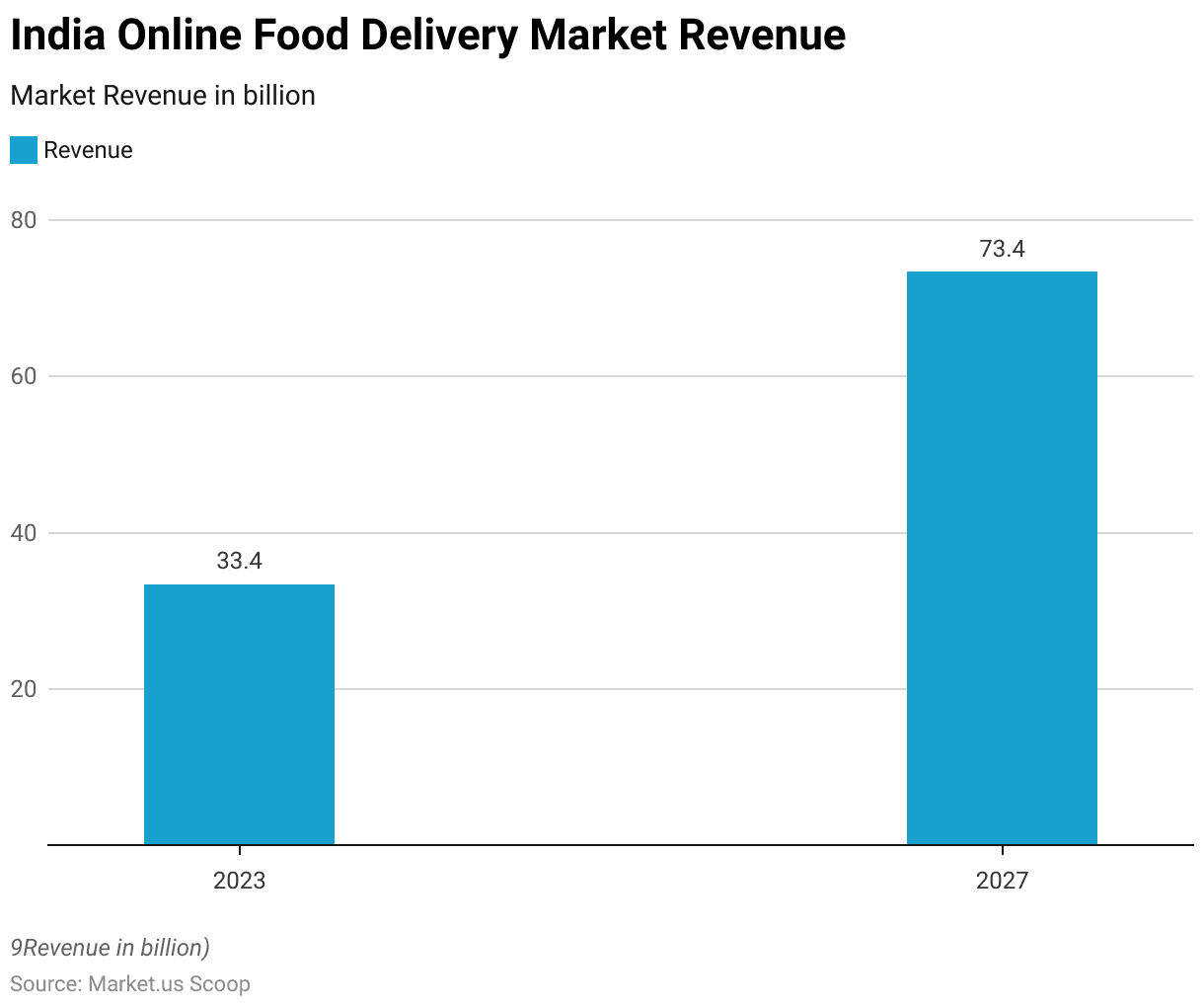
United States
- The U.S. online food delivery market is on track to generate approximately $269.80 billion in revenue in 2023.
- Anticipated to grow at an annual rate of 15.10% from 2023 to 2027. The market’s overall size is projected to reach $473.50 billion by 2027.
- Notably, the Grocery Delivery sector is expected to experience significant revenue growth, with a predicted 29.0% increase in 2024.
- Currently, the largest segment within this market is Grocery Delivery. Estimated to be around $182.90 billion in market volume in 2023.
- Regarding global revenue comparisons, China is expected to lead with an estimated $395.9 billion in 2023.
- Furthermore, the Average Revenue Per User (ARPU) for the Grocery Delivery segment is forecasted to be approximately $1.36 thousand in 2023.
- Shifting focus to the Meal Delivery segment, it is projected to attract around 189.4 million users by 2027, with a user penetration rate of 48.0% in 2023.
- When considering the penetration rate in the online food delivery market. The United States ranks highest at 63.8%, closely followed by the United Kingdom at 63.07%.
- In contrast, India lags in this ranking with a rate of 19.99%. Marking a significant gap of 43.81% points compared to the United States.
(Source: Statista)
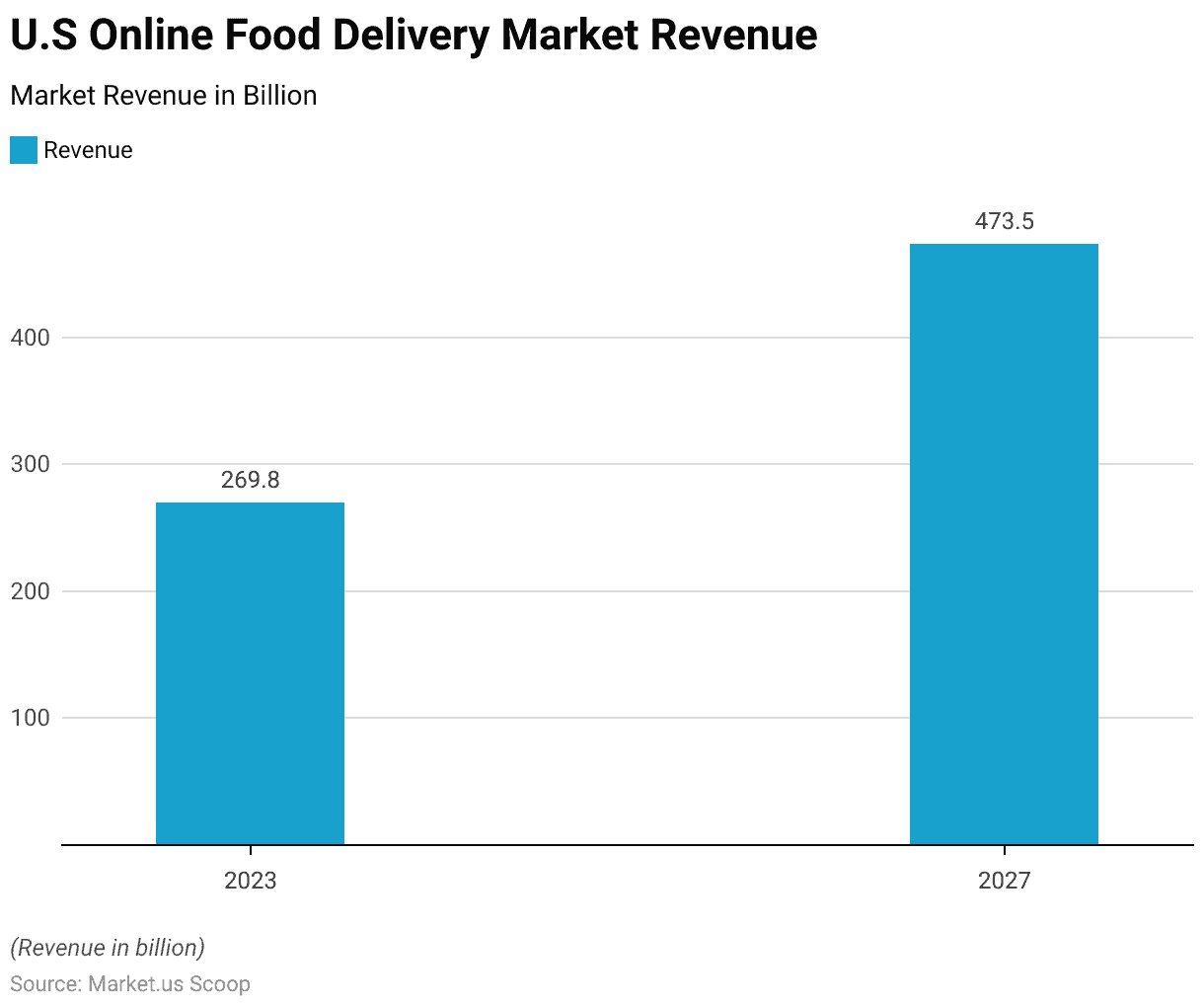
China
- Projections for the China Online Food Delivery market indicate it is on track to achieve a revenue of approximately US$395.90 billion by 2023.
- This upward trajectory is anticipated to continue with an expected annual growth rate (CAGR) of 10.30% from 2023 to 2027. Resulting in a market volume forecasted to reach US$585.90 billion by 2027.
- Particularly noteworthy is the anticipated revenue growth of 17.6% in 2024 for the Grocery Delivery segment. Which currently holds the position of the largest segment in this market, with a projected market volume of around US$226.10 billion in 2023. Globally, China is poised to lead in revenue generation, with an estimated US$395.9 billion in 2023.
- Furthermore, the Average Revenue Per User (ARPU) in the Grocery Delivery segment is expected to reach approximately US$487.00 in 2023.
- Shifting the focus to the Meal Delivery segment, it is projected to witness substantial user growth. Reaching approximately 0.9 billion users by 2027, with a user penetration rate of 51.6% in 2023.
(Source: Statista)
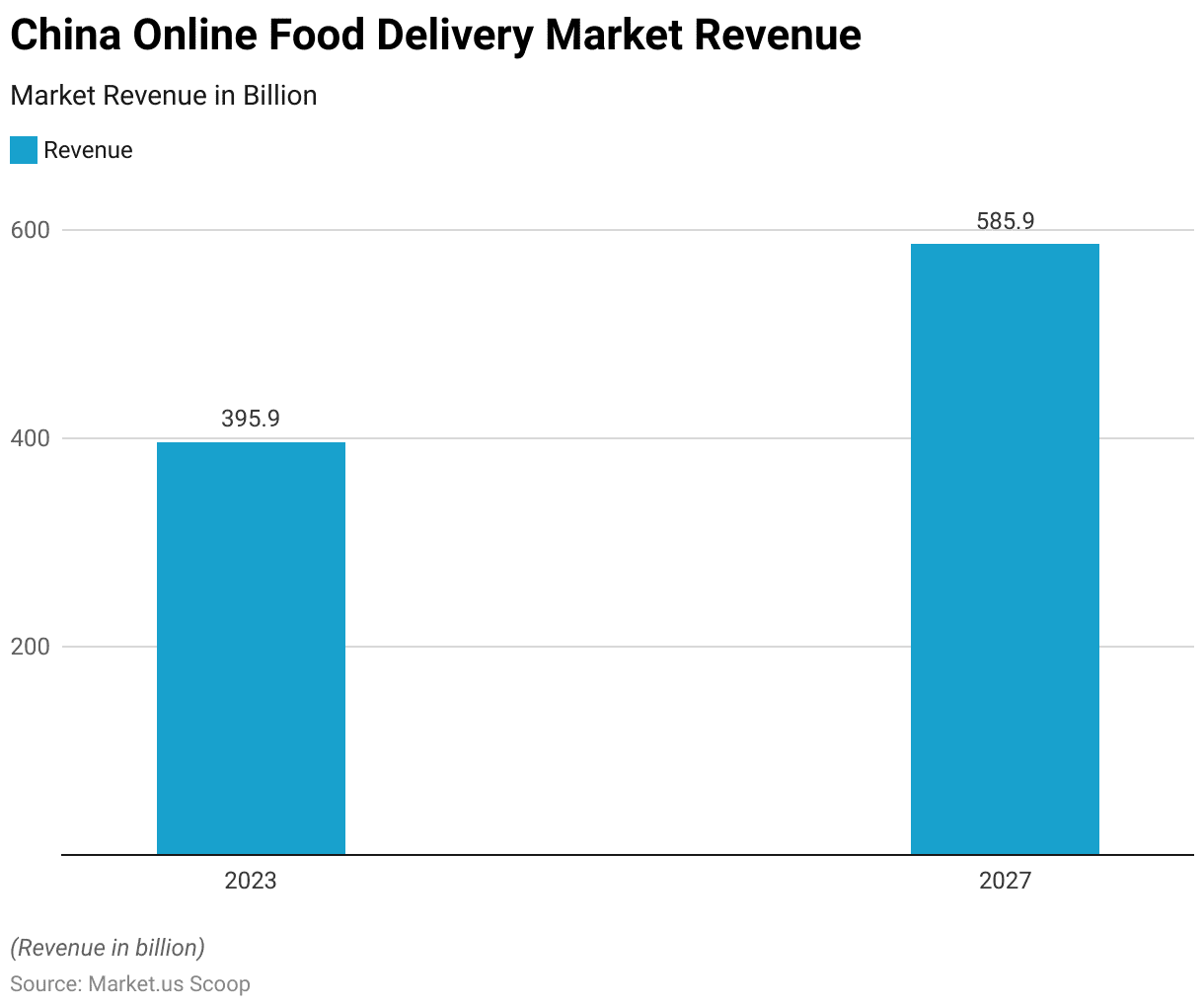
Online Food Delivery Statistics by Top Companies
- In the fiscal year 2022, Zomato recorded revenue exceeding 55 billion Indian rupees. The majority of its revenue came from its food delivery services. Although Zomato held a dominant position in the market, its closest rival in recent times has been Swiggy.
- In 2022, Uber Eats, the food delivery company, achieved global revenues of nearly 11 billion U.S. dollars. This amount signifies a notable increase of 31% compared to the previous year when the company generated 8.3 billion dollars in revenue.
- In 2019, Swiggy, a food delivery company based in Bangalore, averaged approximately 1.4 million daily orders. This made Swiggy one of the top players in the market in terms of revenue.
- During the same year, Zomato was another major player in India’s food delivery market. They recorded 1.3 million daily orders, highlighting its substantial presence in the industry.
- The platform-to-consumer segment took the lead in the industry, capturing the largest share. Which amounted to over 71.75% of the total revenue.
- Similarly, the mobile application segment was the dominant force in the industry during the same year, contributing the most substantial portion of revenue, accounting for over 75.25% of the total earnings.
Zomato
- During the financial year 2022, Zomato demonstrated remarkable growth in its food delivery operations, processing over 535 million orders, which represented a staggering 124% increase compared to the previous year, a period marred by the COVID-19 pandemic.
- Notably, in the final quarter of that year, Zomato’s food delivery business generated 12.8 billion rupees in revenue, surpassing the performance of earlier quarters.
- While Zomato does diversify its revenue streams through the Hyperpure segment, which focuses on B2B supplies, it’s worth noting that this segment contributes significantly less to the company’s overall revenue when compared to its core food delivery operations.
Deliveroo
- In 2022, Deliveroo saw a revenue of £1.9 billion, marking an 8.2% increase compared to the previous year.
- The company also cut down its net loss from £298 million in 2021 to £245 million in 2022.
- With a user base primarily concentrated in the United Kingdom, Deliveroo boasts 7.4 million users.
- However, it faced a significant setback when it went public, as its stock lost 31% of its value on the first day of its IPO, as reported by Bloomberg.
Grubhub
- In 2022, Grubhub reported a revenue of $2.4 billion, marking a 5% year-on-year increase.
- During the same period, the company’s gross transaction volume hit $10.1 billion.
- Grubhub maintains a user base of 28.3 million active monthly app users, boasting partnerships with over 300,000 restaurants across 4,000 cities.
DoorDash
- DoorDash, the U.S.-based food delivery company, witnessed a substantial revenue surge in recent years. In 2021, it generated $4.8 billion, nearly doubling its previous year’s results.
- The following year, in 2022, DoorDash reported even more impressive figures, with revenues reaching approximately $6.6 billion, representing a notable 34% increase from the previous year.
- However, it also disclosed its highest annual net loss, amounting to $1.3 billion. Founded in 2013 in Palo Alto, California, DoorDash has amassed a user base of 32 million, with the majority hailing from the United States.
- Notably, according to Second Measure, DoorDash holds a commanding market share in the U.S., exceeding 60%.
- DoorDash was originally founded in Palo Alto, California, in 2013, and it has since become a prominent player in the food delivery industry.
- DoorDash achieved revenues of 4.8 billion U.S. dollars in 2021, nearly doubling its previous year’s results.
- The company, which is based in the United States and specializes in food delivery, experienced even more substantial growth in 2022, with revenues soaring to 6.6 billion U.S. dollars.
Uber Eats
- Uber Eats, a global food delivery service, operates in over 6,000 cities across more than 45 countries and has seen remarkable growth in recent years.
- In 2020, it reported revenues of $4.8 billion and experienced a staggering 152% year-over-year growth during Q2.
- It holds a substantial 22% market share within the United States, and its average order value is $26.19.
- Impressively, 34% of millennials and 29% of Generation Z utilize Uber Eats, contributing to a 54% year-over-year increase in its user base in 2020.
- Uber Eats garners high satisfaction, with 81% of its users content with the platform. The service operates on a 30% commission model from restaurants, and promotional discounts have attracted one in four users.
- Additionally, drivers earn an average hourly wage of $8.46, and 12.8% of total bookings in the previous year were attributed solely to Uber Eats, making it a significant player in the food delivery landscape with an average of 75 million monthly users.
Online Food Delivery Statistics by Consumer Behaviour
- As per the study, 37.3% of respondents within the 18 to 30-year-old age group reported using food delivery platforms to order food once a month. While an additional 33.3% use these platforms less than three times a week.
- Furthermore, a significant 73.5% of respondents expressed their interest in ordering food from a food delivery platform during dinner time.
- Among them, 62.8% preferred ordering food less than three times a week specifically during dinner hours.
- The majority of respondents, specifically 84.3% in the 18 to 30 age group, showed a strong preference for using Zomato when ordering food.
- Additionally, a significant percentage, approximately 90%, of respondents who ordered food online and had a family income of up to 2 lahks. As well as 83.8% of those with a family income ranging from 5.1 lakhs to 7.5 lakhs. Expressed a desire to make payments using Google Pay, particularly for transactions exceeding 200 rupees.
- In the survey data, it’s evident that 86.2% of respondents who order food online between 3 to 6 times from a food delivery platform consider the ease and convenience factor to be of utmost importance.
- Additionally, the survey revealed that 43.1% of respondents in the 18 to 30 age group have encountered issues. Which related to extended loading or delivery times while ordering food through a food delivery platform.
- These respondents expressed a high level of dissatisfaction due to the delays they experienced when using food delivery platforms.
(Source: iims Pune)
Online Food Delivery Customer Preference Statistics
- Gen Z has a strong affinity for online ordering, finding it more convenient than traditional paper menus. According to a recent study by e-marketer, over 55% of consumers in the 18-25 age group embraced online ordering in the past year.
- Interestingly, a significant majority, seven out of ten Gen Z takeout eaters, indulge in TV-watching while enjoying their meals. A trend diminishes with age, with only 25% of users above 55 opting for online food orders.
- This shift in dining habits has also increased viewership on online streaming platforms like Amazon and Netflix.
- Additionally, the USA and the UK have seen a rise in working mothers, surpassing 65%. Who often find themselves pressed for time when it comes to meals, driving their preference for food delivery apps.
(Source: illuminate)
Recent Developments
Acquisitions and Mergers:
- Uber Eats acquires Postmates: In mid-2023, Uber Eats completed its $2.65 billion acquisition of Postmates. This acquisition aims to consolidate Uber Eats’ market position in the U.S. and enhance its delivery network. Expanding its customer base and restaurant partnerships.
- DoorDash acquires Wolt: DoorDash acquired Wolt, a Finnish food delivery service, for $8.1 billion in late 2023. This merger is expected to boost DoorDash’s presence in the European market and expand its global footprint. Offering more delivery options and restaurant choices.
New Product Launches:
- Grubhub’s Subscription Service: In early 2024, Grubhub launched a new subscription service called Grubhub+, offering unlimited free delivery, exclusive perks, and special discounts for a monthly fee. This service aims to enhance customer loyalty and increase repeat orders.
- Deliveroo’s Editions Expansion: Deliveroo announced the expansion of its Editions program in mid-2023, which involves setting up delivery-only kitchens to serve high-demand areas without physical restaurants. This initiative aims to reduce delivery times and increase food variety for customers.
Funding:
- Zomato raises $500 million: In 2023, Zomato, a leading food delivery platform in India, raised $500 million in a funding round to expand its operations, improve technology, and enhance customer service, focusing on increasing its market share in the competitive Indian market.
- Swiggy secures $700 million: Swiggy, another major player in India, secured $700 million in early 2024 to develop new services, expand its grocery delivery platform, Instamart, and invest in drone delivery technology for faster and more efficient deliveries.
Technological Advancements:
- AI and Machine Learning Integration: Online food delivery platforms are increasingly integrating AI and machine learning to optimize delivery routes, predict customer preferences, and improve order accuracy, leading to faster and more personalized service.
- Drone and Autonomous Delivery: Companies like Swiggy and Uber Eats are experimenting with drone and autonomous vehicle delivery technologies to reduce delivery times and operational costs, especially in urban areas.
Market Dynamics:
- Growth in Online Food Delivery Market: The global online food delivery market is projected to grow at a CAGR of 10.5% from 2023 to 2028, driven by increasing consumer demand for convenience, the rise of digital ordering, and the expansion of delivery services into new markets.
- Rising Popularity of Subscription Services: Subscription-based models are becoming increasingly popular among food delivery platforms as they offer steady revenue streams and enhance customer retention through perks like free delivery and exclusive discounts.
Regulatory and Strategic Developments:
- EU Regulations on Gig Economy Workers: The European Union implemented new regulations in early 2024 to improve the working conditions of gig economy workers, including food delivery couriers. These regulations aim to ensure fair wages, benefits, and better job security.
- US Federal Trade Commission (FTC) Guidelines: The US FTC issued new guidelines in 2023 to promote transparency and fairness in the food delivery industry. Focusing on clear pricing, service fees, and customer data protection.
Research and Development:
- Sustainable Packaging Solutions: R&D efforts are focusing on developing sustainable and eco-friendly packaging solutions for food delivery to reduce environmental impact and cater to the growing consumer demand for green practices.
- Health and Safety Measures: Researchers are exploring advanced health and safety measures for food delivery, including contactless delivery options, improved food handling protocols, and real-time tracking systems to ensure the freshness and safety of delivered food.
Conclusion
Online Food Delivery Statistics – The online food delivery market has experienced substantial growth and transformation in recent years, with major players like Deliveroo, Grubhub, DoorDash, Uber Eats, and Zomato reporting significant increases in revenue and user adoption.
The convenience and flexibility of ordering food online, especially among younger generations, have driven this expansion.
However, the market is highly competitive, and companies constantly innovate to gain a competitive edge.
Additionally, the impact of external factors like the COVID-19 pandemic has accelerated the adoption of online food delivery services.
While these platforms offer lucrative opportunities, challenges such as profitability and competition remain, making it a dynamic and evolving sector in the broader food industry.
FAQs
The online food delivery market refers to the industry where consumers can order food from restaurants and deliver it to their doorstep using online platforms and mobile apps.
Customers typically use a mobile app or website to browse menus, place orders, and make payments. Restaurants receive the orders through a dedicated system, prepare the food, and hand it over to delivery drivers or services for delivery to the customer.
Major players in the market include companies like Uber Eats, DoorDash, Grubhub, Postmates (now part of Uber Eats), and Just Eat Takeaway.com, among others.
The market includes segments like Meal Delivery and Grocery Delivery. The Meal Delivery segment is expected to grow substantially, with an 18.8% revenue increase in 2024. Grocery Delivery is the largest segment, projected to reach around US$80.78 billion in 2023.
Factors such as convenience, a wide variety of food options, the rise of online ordering and delivery platforms, and changing consumer preferences for dining at home have contributed to the growth of this market.
Discuss your needs with our analyst
Please share your requirements with more details so our analyst can check if they can solve your problem(s)



